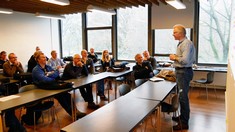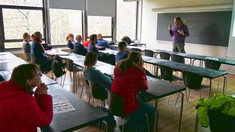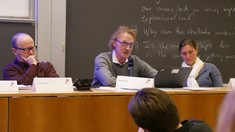Experiences with computational mathematics teaching
Four years after the formation of Centre of Computational Mathematics Education (CMU) it's time for researchers and lecturers to reflect upon the challenges the growing use of mathematical software constitutes for the mathematics education of the high school.
On 15 November 2017, participants from upper-secondary school, Ministry of Education, higher education and other players from the educational sector met at the conference 'Computational mathematics teaching in upper secondary schools - four years with the CMU." The conference marked the preliminary conclusion to four years of cooperation between the CMU and upper secondary school teachers about the use of CAS programs in mathematics lessons (CAS is an abbreviation for Computer Algebra System).
Video from the conference's presentations and panel debates can be seen on the centre's website, cmu.math.ku.dk.
Diluted academic standards or a robust tool
The growing use of mathematical software poses many challenges. On the one hand, there is a risk that the tools will dilute the academic content by reducing mathematical work to barren use of templates. On the other hand, the powerful tools constitute a potential together with non-instrumented mathematics which can be developed into a single, deep and robust mathematical preparedness.
The universities have an obligation to assure the quality of the upper secondary schools. Department of Mathematical Sciences has assumed that task, first through pilot projects with the 'NØRD schools’, a consortium of upper secondary schools in Greater Copenhagen region, and subsequently as initiator to the Centre for Computational Mathematics Teaching.
CMU was formed with the mission to promote the synergies between digital and non-digital mathematics made possible by the CAS programs.
The Centre's work concerns the development of teachers and courses; about dialogue and commonality concerning the use of CAS. CMU sees this as a bottom-up process where the teacher is a "contemplative practitioner' who develops and examines ideas with CAS in hers or his own teaching and subsequently reflect upon the experiences with a view to future practice.
CMU supports participating teachers in this work through coaches, which is partly collegial sparring partners and partly can help with concrete problems in relation to CAS solutions. Approximately 90 upper secondary school teachers have over the years successfully completed CMU projects.

John Monaghan
Where to go with CAS?
The conference was opened with Henrik Bang’s and Claus Larsen's presentation, Experience from four years with the CMU, focussing on the need for systematic strategic planning of the use/non-use of CAS. Furthermore, it highlighted the importance of explicit work to transform CAS to a personal instrument for targeted math work (for both teacher and pupil).
Digital tool use in 14-21 mathematics education: where we’ve come from and where we might be going – was the title of John Monaghan presentation. Monaghan is one of the world's leading researchers in mathematics didactic and has contributed with research and educational counselling since the early 80's, especially regarding the use of computer tools. He gave a personalized report on the development of the use of digital tools and perspectives for the future. Monaghan is employed at the University of Agder (Norway) and Leeds University (England).
Then, a selection of the CMU projects was presented in three parallel sessions, spanning from the introduction of the CAS tool to concept supporting and experimental uses.
The last speakers at the conference were two professors from Department of Mathematical Sciences, Jan Philip Solovej and Søren Eilers, each with their own angle: Reflections on 15 years of encouraging and disappointing experience with computer-based mathematics teaching.
Jan Philip Solovej talked about the original ambitions with the introduction of Maple in the introductory maths teaching on UCPH - and the disappointments. Maple was only to a limited extent caught on by the students as a tool for calculations, experiments and visualisation. And the subsequent mathematics teaching had not followed up.
Søren Eilers then talked about his encouraging experiences in his work with Experimental Mathematics. This approach to mathematics is unthinkable without the use of computers.

Better exams and training opportunities
The conference ended with a panel discussion of the use of mathematical software in tomorrow's maths teaching in primary, lower-secondary schools and higher education. The panel was composed of a wide range of participants from the education system and the recipients, with computer advocates and computer sceptics.
All could, however, put forward weighty examples of productive use of mathematical software. There seemed to be more or less agreement on that a prerequisite for realising this is supporting exam forms, and that a significant obstacle is the teachers' experienced workload and the reduced opportunities for supplementary training.
CMU continues
CMU has received funding from the Danish Industry Foundation, Department of Mathematical Sciences, Ministry of Education and Maplesoft. This support expires at the end of 2017. But CMU does not close. CMU will continue to work on a number of focus areas. CMU's current project concept will be continued in the form of a course under Open Education.
Digital tools have also growing importance in primary schools. Denmark's Mathematics Teacher Association, therefore, apply for funding for CAS projects aimed at the transition between primary, lower secondary and upper secondary school. If the application is accepted, the Centre will provide project execution based on the CMU model. Finally, there are plans to develop and provide curricula for upper secondary school with a focus on digital and discrete mathematics.
Contact
Niels Grønbæk
Dep. of Mathematical Sciences
University of Copenhagen
Universitetsparken 5
2100 København Ø
Fotos fra konferencen










